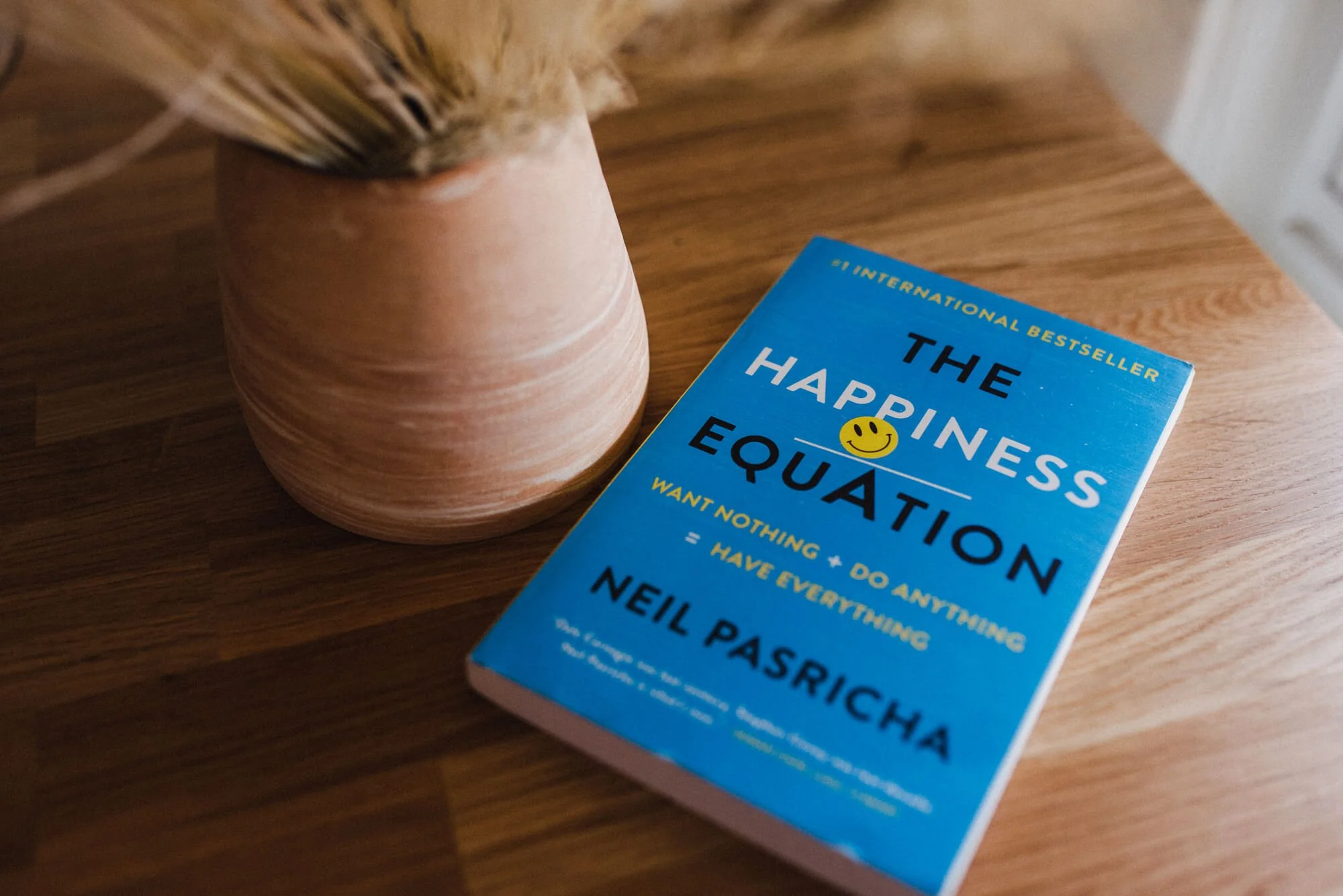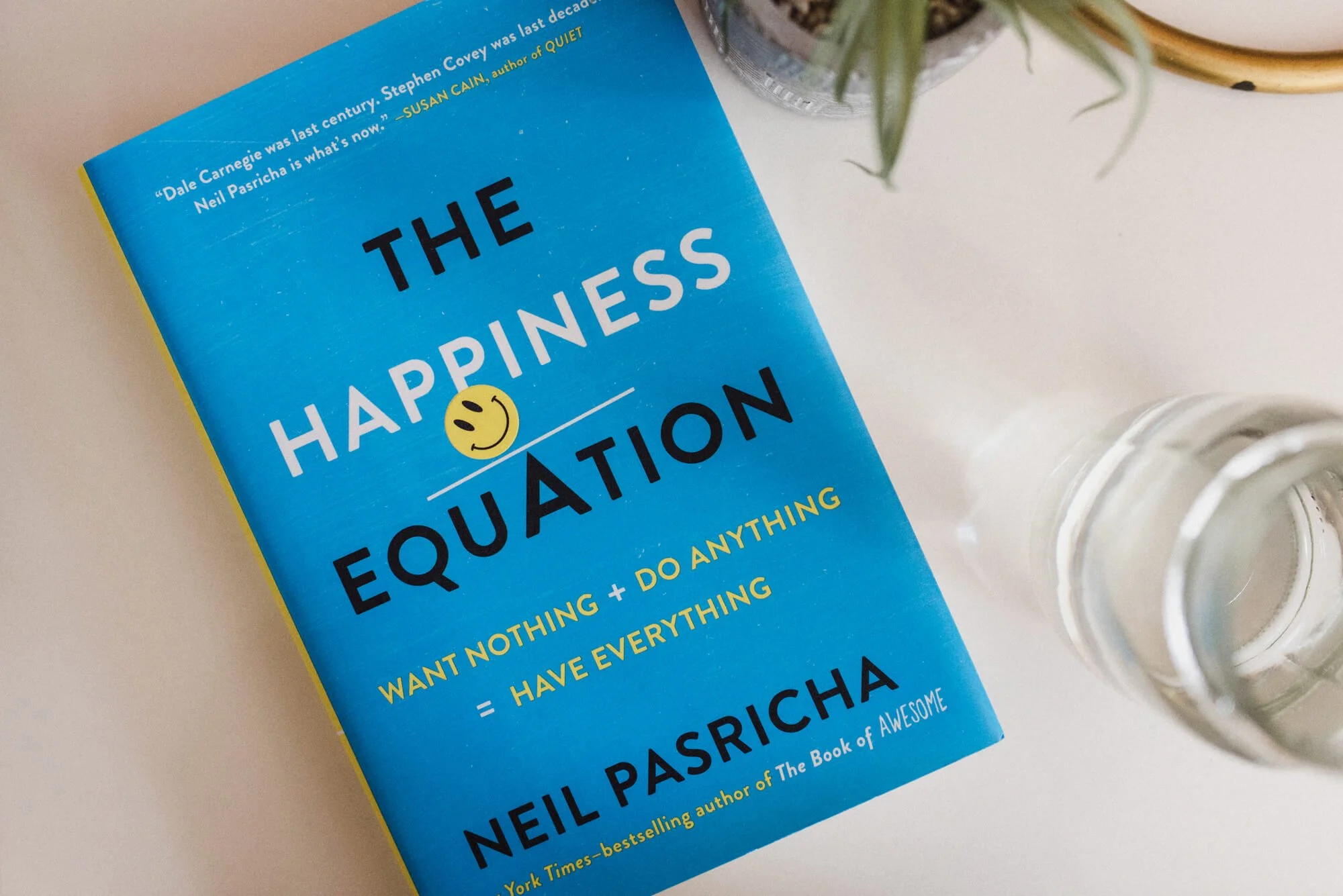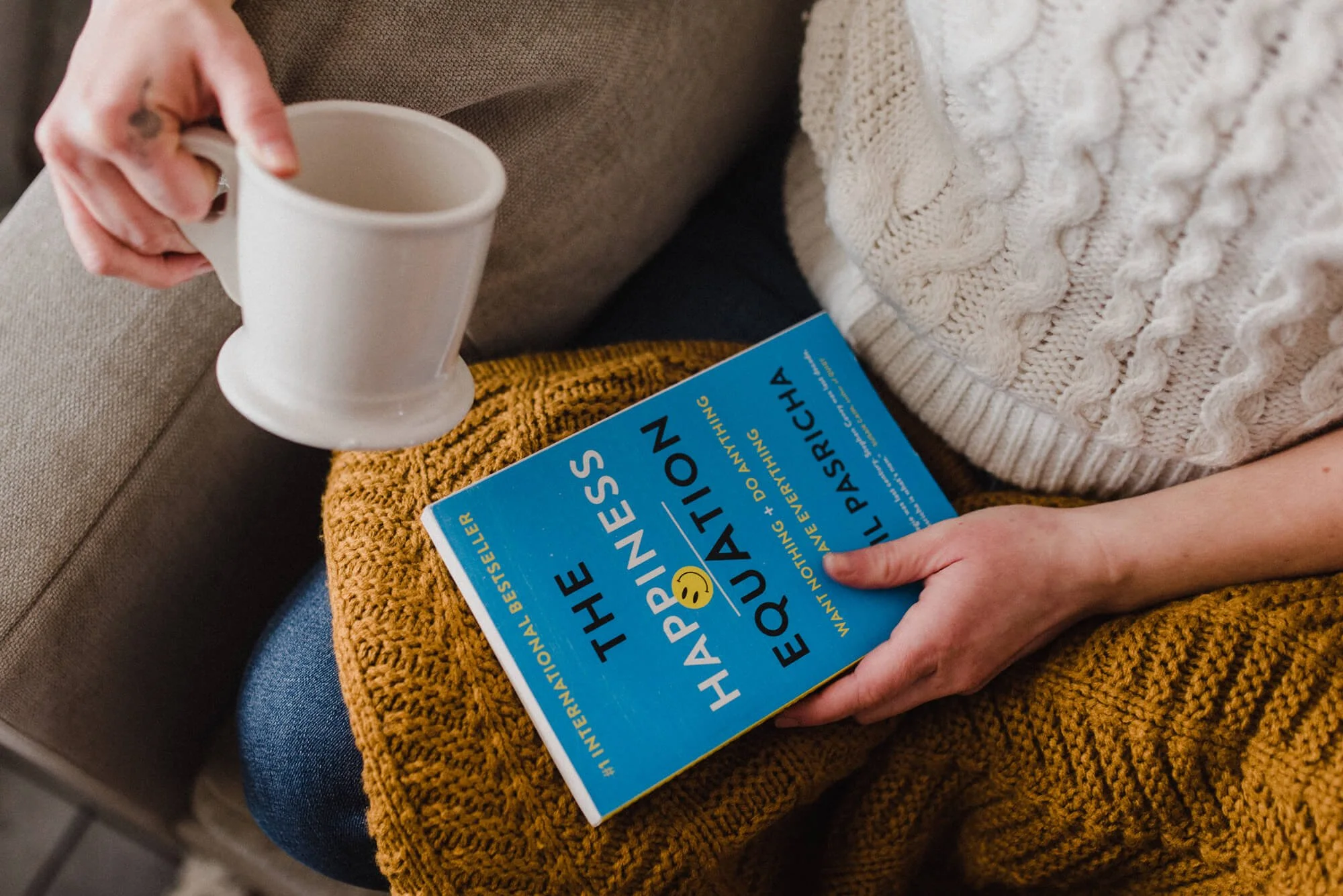The Happiness Equation
By Neil Pasricha
What is the formula for a happy life? In the groundbreaking book 'The Happiness Equation,' Neil shares nine research-backed arguments to provoke your thinking and create new habits.
#1 INTERNATIONAL BESTSELLER
GET YOUR COPY AT YOUR LOCAL INDIE BOOKSTORE OR ORDER ONLINE AT…
“Dale Carnegie was last century. Steven Covey was last decade. Neil Pasricha is what’s now. The Happiness Equation is a two-hour ticket to changing your life!”
–SUSAN CAIN, author of Quiet: The Power of Introverts in a World That Can’t Stop Talking
“I’m blown away by The Happiness Equation. Neil’s nine secrets will improve how you think, how you feel, and how you act!”
–KEN BLANCHARD, coauthor of The New One Minute Manager and Refire! Don’t Retire
“Clear, practical, and thought-provoking, The Happiness Equation reveals how all of us can live happier lives.”
–GRETCHEN RUBIN, author of Better Than Before and The Happiness Project
Thousands of hours later, this book contains all the answers. From greeting to meeting, from boardroom to bedroom, it’s all here, and it will change your life in two hours. You will learn principles such as:
Why success doesn’t lead to happiness
How to make more money than a Harvard MBA
Why multitasking is a myth
The 4 simple words that block all criticism
How eliminating options leads to more choice
What the healthiest 100-year-olds teach us about retirement
The 3 S’s of Success
How to add one hour to your day with only one small change
The Bench Test for evaluating any change in your life
The 3 B’s of creating space
The one thing most billionaires want but cannot have
How to make every decision at twice the speed
And much, much more.
The Happiness Equation is a once-in-a-lifetime book that changes how you think about everything—your career, your relationships, and ultimately, of course, yourself.
Excerpt from the Book
1. 6 words that will forever change how you see happiness
Let’s start off with some bad news. The happiness model we’re taught from a young age is actu-ally completely backward. We think we work hard in order to achieve big success and then we’re happy. We think the scribble goes like this:
Study hard! → Straight A’s! → Be happy!
Interview lots! → Great job! → Be happy!
Work overtime! → Get promoted! → Be happy!
But it doesn’t work like that in real life. That model is broken. We do great work, have a big success, but instead of being happy, we just set new goals. Now we study for the next job, the next degree, the next promotion. Why stop at a college degree when you can get a master’s? Why stop at Director when you can be VP? Why stop at one house when you can have two? We never get to happiness. It keeps getting pushed further and further away.
What happens when we snap “Be happy” off the end of this scribble and stick it on the beginning?
Now everything changes. Everything changes. If we start with being happy, then we feel great. We look great. We exercise. We connect. What happens? We end up doing great work because we feel great doing it. What does great work lead to? Big success. Massive feelings of accomplishment and the resulting degrees, promotions, and phone calls from your mom telling you she’s proud of you.
Harvard Business Review reports that happy people are 31% more productive, have 37% higher sales, and are three times more creative than their counterparts.
So what’s the first thing you must do before you can be happy? Be happy. Be happy first.
Being happy opens up your learning centers. Your brain will light up like Manhattan skyscrapers at dusk, sparkle like diamonds under jewelry store lights, glow like stars in the black sky above a farmer’s field.
American philosopher William James says, “The greatest discovery of any generation is that a human being can alter his life by altering his attitude.”
The Happiness Advantage author Shawn Achor says, “It’s not necessarily the reality that shapes us but the lens through which your brain views the world that shapes your reality.”
William Shakespeare says, “For there is nothing either good or bad, but thinking makes it so.”
2. The single biggest reason it’s so hard to be happy
Shakespeare says, “For there is nothing either good or bad, but thinking makes it so.” But if it’s just thinking, plain thinking, why can’t we think ourselves into a good mood whenever we want?
Seems like we should be able to just flip a mental switch.
But we all know it’s not that easy. Sometimes our brains get focused on negative things. We can’t stop! I do this all the time. And you want to know a secret? Everybody does. Every single person gets stuck focusing on the negative sometimes. I’ve spoken on stages with the best-known motivational speakers, Fortune 500 CEOs, and political leaders from around the world. Do you know what they’re all doing backstage? Freaking out. Sweating. Thinking something might go wrong.
We all have negative self-talk. There is no such thing as an eternal optimist. There are people who feel optimistic, but those people have negative self-talk, too. And that’s okay. The problem isn’t that we have negative thoughts in our brain.
The problem is we think we shouldn’t have negative thoughts.
But why do our brains focus on negative things? Once we understand this we can learn how much we can control and make conscious efforts to be happy using proven techniques.
This is one of the most important things I can share with you. Why is it so hard to be happy?
Because life was mostly short, brutal, and highly competitive over the two hundred thousand years our species has existed on this planet. And our brains are trained for this short, brutal, and highly competitive world.
How short, brutal, and highly competitive was it? Let’s do a quick experiment.
Stop, close your eyes, and picture the last time you felt completely alone in the middle of nowhere.
Was it camping in the mountains when you walked away from the fire and stood on the jagged edge of a mirrory lake? Was it a misty waterfall you found on a field trip when your classmates disappeared and all you could hear was the wind rustling the leaves in the forest canopy? Was it jogging at sunrise on a sandy beach when you curled around the coastline and suddenly couldn’t see anyone for miles in any direction?
Picture yourself back in that scene.
Now mentally erase from our planet all of the following:
• Toilets
• Sinks
• Showers
• Running water
• Computers
• Phones
• Internet
• Beds
• Chairs
• Roads
• Bikes
• Cars
• Planes
• Boats
• Books
• Paper
• Pencils
• Pens
• Hospitals
• Doctors
• Medicines
• Tools
• Grocery stores
• Fridges
• Freezers
• Farms
• Stoves
• Microwaves
• Shirts
• Sweaters
• Jackets
• Pants
• Socks
• Shoes
• Underwear
3. The one thing your doctor, teacher, and Tom Hanks all have in common
Yes, that fear is still programmed into our heads.
It’s everywhere, it’s between our ears, it’s in our brains. Tom Hanks, one of the world’s most successful actors, who earns millions with every movie and has scored two Academy Awards, said, “Some people go to bed at night thinking, ‘That was a good day.’ I am one of those who worries and asks, ‘How did I screw up today?’”
Andy Grove is the longtime Intel executive who helped trans- form the company into a multibillion-dollar success. He was be- lieved by many to have helped drive the growth phase of Silicon Valley, was named Time’s Man of the Year in 1997, and was idolized by Steve Jobs, according to Jobs’s biography. How did he famously put it? “Only the paranoid survive.”
Our brains still follow this paranoid model every day, and it is a recipe for unhappiness! Some call it Medical Student’s Syndrome. That’s a term Jerome K. Jerome first coined in his 1889 classic, Three Men in a Boat: “I remember going to the British Museum one day to read up the treatment for some slight ailment of which I had a touch—hay fever, I fancy it was. I got down the book, and read all I came to read; and then, in an unthinking moment, I idly turned the leaves, and began to indolently study diseases, generally. I forget which was the first distemper I plunged into—some fearful, devastating scourge, I know—and, before I had glanced half down the list of ‘premonitory symptoms,’ it was borne in upon me that I had fairly got it.
“I sat for a while, frozen with horror; and then, in the listlessness of despair, I again turned over the pages. I came to typhoid fever— read the symptoms—discovered that I had typhoid fever, must have had it for months without knowing it—wondered what else I had got; turned up St. Vitus’s Dance—found, as I expected, that I had that, too—began to get interested in my case, and determined to sift it to the bottom, and so started alphabetically—read up ague, and learnt that I was sickening for it, and that the acute stage would commence in about another fortnight . . .”
It’s not just medical students. We’ve all been there.
We scan the world for problems because that led to our survival. And our current design of the world only reinforces and grows these negative-lens feelings.
At your doctor’s office when you get lab results, the doctor says, “Your blood sugar is fine, your cholesterol is fine, but your iron is low.” What do you do? You talk about getting your iron up. Eat steak! No work is done improving your blood sugar or cholesterol. If cholesterol should be below 200mg/dL and you’re at 195, great! If you’re 205, that’s a problem. Doctors get paid when we’re sick. Shouldn’t we pay them when we’re healthy?
Retail store managers “manage by exception” by staring at morning reports, finding a number below average, and trying to bump it up. If that report says your traffic count is fine, basket size is fine, but checkout time is below average, what does the boss want? Faster checkouts. More cashiers! No work is done improving statis- tics that are already average.
In the classroom the teacher hands back test results and offers extra help to those below average. They have to pass! If not, the year is repeated, the system is drained, friends all move ahead. What happens for the below average kids? Extra help at lunch. Tutoring sessions. Remedial tests. Why aren’t students who get 100% offered any extra challenge?
It’s no different in the workplace. We get job evaluations showing how well we’re doing. What happens if you’re below expectations
Performance improvement plan! Extra meetings with the boss! Shipped to training classes! What happens if you’re doing well? Two percent raise. Pat on the back.
Rather than find good results and make them better, our brains do this:
1. Look for problem.
2. Find problem.
3. Improve problem.
That’s what our brains have been trained to do for two hundred thousand years. But because we scan the world for problems, sometimes that’s all we see. Here’s how New York Times–bestselling author Kelly Oxford framed our Medical Student’s Syndrome on Twitter:
“WebMD is like a Choose Your Own Adventure book where the ending is always cancer.”
So what do we do about it?
4. How much can we control?
Aristotle says, “Happiness depends upon ourselves.”
Viktor Frankl says, “Everything can be taken from a man but one thing: the last of the human freedoms—to choose one’s attitude in any given set of circumstances, to choose one’s own way.” Walt Whitman writes, “Keep your face always toward the sunshine—and shadows will fall behind you.”
I love what Artistotle, Viktor Frankl, and Walt Whitman say. But how do you get there?
Well, we now have scientific evidence of the importance of attitude and specific proven actions we can take to manage our attitude.
Do you know what’s amazing about this quote? The second last sentence!
“I am convinced that life is 10% what happens and 90% how I react to it.”
Well, new research published in The How of Happiness by University of California psychology professor Sonja Lyubomirsky tells us exactly how much of our happiness is based on our life circumstances.
And it is 10%!
10% of our happiness is what happens to us.
So 90% of our happiness isn’t based on what’s happening in the world! It’s based on how we see the world. What’s included in the 90%? Our genetic predisposition and our intentional activities. Yes, intentional activities. This is big. Those are specific things we can do to improve our happiness. And they alone have four times the effect on our happiness than anything happening in our life.
Let me put it another way: If I knew everything about your life circumstances—your job, your health, your marital status, your income—I could predict only 10% of your happiness. That’s it!
The remaining amount is not determined by your external world but by the way your brain processes it.
5. 7 ways to be happy right now
How do you be happy first?
For this chapter we look to the emerging field of positive psychology. What’s that? It’s not fluffy lollipop experiments. Professors of psychology Martin Seligman and Mihaly Csikszentmihalyi are called the fathers of positive psychology because of their passion for cold hard facts. As they put it themselves in American Psychologist:
“Psychology is not just a branch of medicine concerned with illness or health; it is much larger. It is about work, education, insight, love, growth, and play. And in this quest for what is best, positive psychology does not rely on wishful thinking, faith, self-deception, fads, or hand-waving; it tries to adapt what is best in the scientific method to the unique problems that human behavior presents to those who wish to understand it in all its complexity.”
Positive psychology is a new and growing field.
I have sifted through hundreds of studies to find the Big 7 ways to train your brain to be happy. Many of these studies have been discussed in journals, conference keynotes, and research reports, but I’ve brought them together for you here.
If you do any of these seven things for two straight weeks, you will feel happier.
So what are the Big 7?
1. Three Walks
Pennsylvania State researchers reported in the Journal of Sport & Exercise Psychology that the more physically active people are, the greater their general feelings of excitement and enthusiasm. Researcher Amanda Hyde reports, “We found that people who are more physically active have more pleasant-activated feelings than people who are less active, and we also found that people have more pleasant-activated feelings on days when they are more physically active than usual.” It doesn’t take much: Half an hour of brisk walking three times a week improves happiness. The American Psychosomatic Society published a study showing how Michael Babyak and a team of doctors found that three thirty-minute brisk walks or jogs even improve recovery from clinical depression. Yes, clinical depression. Results were stronger than studies using medication or studies using exercise and medication combined.
2. The 20-Minute Replay
Writing for twenty minutes about a positive experience dramatically improves happiness. Why? Because you actually relive the experience as you’re writing it and then relive it every time you read it. Your brain sends you back. In a University of Texas study called “How Do I Love Thee? Let Me Count the Words,” research- ers Richard Slatcher and James Pennebaker had one member of a couple write about their relationship for twenty minutes three times a day. Compared to the test group, the couple was more likely to engage in intimate dialogue afterward and the relationship was more likely to last. What does the 20-Minute Replay do? It helps us remember things we like about people and experiences in our lives.
3. Random Acts of Kindness
Carrying out five random acts of kindness a week dramatically im- proves your happiness. We don’t naturally think about paying for someone’s coffee, mowing our neighbor’s lawn, or writing a thank- you note to our apartment building security guard at Christmas. But Sonja Lyubomirsky, author of The How of Happiness, did a study asking Stanford students to perform five random acts of kindness over a week. Not surprisingly, they reported much higher happiness levels than the test group. Why? They felt good about themselves! People appreciated them. In his book Flourish, Professor Martin Seligman says that “we scientists have found that doing a kindness produces the single most reliable momentary increase in well-being of any exercise we have tested."
4. A Complete Unplug
“The richest, happiest and most productive lives are characterized by the ability to fully engage in the challenge at hand, but also to disengage periodically and seek renewal,” say Jim Loehr and Tony Schwartz in The Power of Full Engagement. And a Kansas State University study found that complete downtime after work helps us recharge for the next day. Turning your phone off after dinner. Not using the Internet on vacation. There’s a lot more to this, and we’re going to chat about it in Secret #6. If you can’t wait, flip to page 145.
5. Hit Flow
Get into a groove. Be in the zone. Find your flow. However you characterize it, when you’re completely absorbed with what you’re doing, it means you’re being challenged and demonstrating skill at the same time. Mihaly Csikszentmihalyi describes this moment as “being completely involved in an activity for its own sake. The ego falls away. Time flies. Every action, movement, and thought follows inevitably from the previous one, like playing jazz. Your whole being is involved, and you’re using your skills to the utmost.” In his book Flow: The Psychology of Optimal Experience, he describes it using an image I’ve redrawn on the following page:
6. 2-Minute Meditations
A research team from Massachusetts General Hospital looked at brain scans of people before and after they participated in a course on mindfulness meditation and published the results in Psychiatry Research. What happened? After the course, parts of the brain associated with compassion and self-awareness grew while parts as- sociated with stress shrank. Studies report that meditation can “permanently rewire” your brain to raise levels of happiness.
7. Five Gratitudes
If you can be happy with simple things, then it will be simple to be happy. Find a book or a journal, or start a website, and write down three to five things you’re grateful for from the past week. I wrote five a week on 1000awesomethings.com. Some people write in a notebook by their bedside. Back in 2003, researchers Robert Emmons and Michael McCullough asked groups of students to write down five gratitudes, five hassles, or five events that happened over the past week for ten straight weeks. Guess what happened? The students who wrote five gratitudes were happier and physically healthier. Charles Dickens puts this well: “Reflect upon your present blessings, of which every man has many, not your past misfortunes, of which all men have some.”
Those are the Big 7. You know it’s important to be happy first, and these are the seven ways to get there. Remember: Just like driving a car, throwing a football, or doing a headstand—you can learn to be happier.
“Be happy first. These three words are so counterintuitive that most of us don’t know what to do with them. Neil does.”
–SETH GODIN, author of What To Do When It’s Your Turn
“How is it possible for subtle, non-judgmental lessons to hit you on the head like the proverbial ton of bricks? I’m not sure how he did it, but Neil Pasricha is the modern-day master of what it means to live intentionally. I loved this book!”
–CHRIS GUILLEBEAU, author of The Happiness of Pursuit and The $100 Startup
“While everyone else implies that happiness is ‘out there’, Neil points out that it is really ‘in here’!”
–MARSHALL GOLDSMITH, author of Triggers and What Got You Here Won’t Get You There
GET YOUR COPY AT YOUR LOCAL INDIE BOOKSTORE OR ORDER ONLINE AT…
“This lighted hearted and compelling book presents common sense suggestions for achieving happiness that will most definitely motivate new rituals and change habits in your life.”
–STEVE REINEMUND, Former Chairman and CEO, PepsiCo
“Want to get happy? Steal everything you can from this book.”
–AUSTIN KLEON, author of Steal Like An Artist
“When Neil Pasricha talks, leaders of all levels and backgrounds stop what they’re doing… and listen.”
–HOWARD BEHAR, Former President of Starbucks Coffee
ABOUT NEIL PASRICHA
Neil Pasricha thinks, writes, and speaks about intentional living. He is the New York Times bestselling author of ten books and journals, including The Happiness Equation, and Two Minute Mornings which together have spent over 200 weeks on bestseller lists and have sold over 2,000,000 copies. He hosts the award-winning podcast 3 Books with Neil Pasricha, which features live conversations with guests such as Brené Brown, Quentin Tarantino, and David Sedaris.
He gives over fifty speeches a year to audiences such as Harvard, SXSW, and Shopify. Neil has degrees from Harvard University and Queen’s University. He lives in Toronto with his family.
GET YOUR COPY AT YOUR LOCAL INDIE BOOKSTORE OR ORDER ONLINE AT…
Some Reviews, PR, and Excerpts: Fortune, Time, BusinessInsider (2, 3), Globe and Mail (2), Forbes, Calgary Herald, Harvard Business Review (2), Canada AM, CBC, Creative Live, Macleans, Toronto Star, The Observer, reddit ama, Quora Session, Inc (2)






































